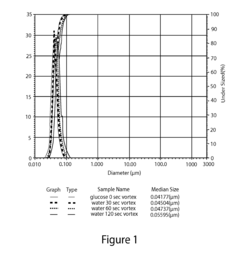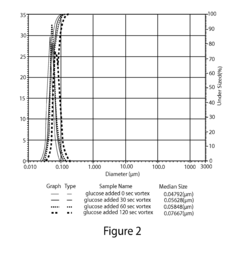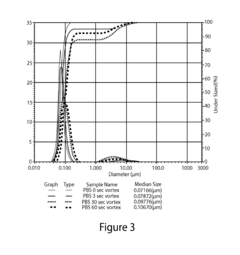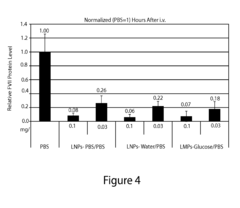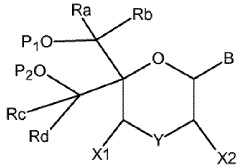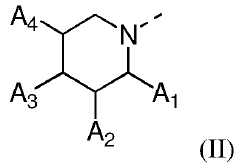How isotonic solutions impact gene therapy efficacy
AUG 19, 20259 MIN READ
Generate Your Research Report Instantly with AI Agent
Patsnap Eureka helps you evaluate technical feasibility & market potential.
Gene Therapy Isotonicity Background and Objectives
Gene therapy has emerged as a promising approach for treating various genetic disorders and diseases. The field has witnessed significant advancements over the past few decades, with researchers and clinicians exploring innovative methods to deliver therapeutic genes to target cells effectively. One crucial aspect that has gained increasing attention is the role of isotonic solutions in gene therapy efficacy.
Isotonic solutions, which have the same osmotic pressure as body fluids, play a vital role in maintaining cellular homeostasis during gene therapy procedures. The historical development of gene therapy has been closely intertwined with the understanding of how isotonicity affects the delivery and expression of therapeutic genes. Early gene therapy attempts often overlooked the importance of solution tonicity, leading to suboptimal results and potential cellular damage.
As the field progressed, researchers began to recognize the critical impact of isotonic conditions on gene transfer efficiency and cell viability. This realization led to a shift in focus towards optimizing the formulation of gene delivery vehicles and the surrounding medium. The evolution of isotonic solutions in gene therapy has been marked by continuous refinement and adaptation to specific therapeutic applications.
The primary objective of investigating isotonic solutions in gene therapy is to enhance the overall efficacy of gene transfer while minimizing potential adverse effects on target cells. Researchers aim to develop isotonic formulations that can protect the genetic payload, facilitate cellular uptake, and promote sustained gene expression. Additionally, there is a growing interest in understanding how isotonicity influences the biodistribution and pharmacokinetics of gene therapy vectors.
Current technological trends in this area include the development of novel isotonic excipients, the exploration of osmolyte combinations, and the integration of isotonicity considerations into advanced delivery systems such as nanoparticles and liposomes. These advancements are driven by the need to improve the stability of gene therapy products, extend their shelf life, and enhance their in vivo performance.
Looking ahead, the field of gene therapy isotonicity is expected to evolve further, with a focus on personalized formulations tailored to specific genetic disorders and patient populations. Researchers are also exploring the potential of manipulating isotonicity to modulate gene expression and cellular responses in a controlled manner. As gene therapy moves towards more complex and targeted approaches, the role of isotonic solutions in optimizing treatment outcomes is likely to become increasingly significant.
Isotonic solutions, which have the same osmotic pressure as body fluids, play a vital role in maintaining cellular homeostasis during gene therapy procedures. The historical development of gene therapy has been closely intertwined with the understanding of how isotonicity affects the delivery and expression of therapeutic genes. Early gene therapy attempts often overlooked the importance of solution tonicity, leading to suboptimal results and potential cellular damage.
As the field progressed, researchers began to recognize the critical impact of isotonic conditions on gene transfer efficiency and cell viability. This realization led to a shift in focus towards optimizing the formulation of gene delivery vehicles and the surrounding medium. The evolution of isotonic solutions in gene therapy has been marked by continuous refinement and adaptation to specific therapeutic applications.
The primary objective of investigating isotonic solutions in gene therapy is to enhance the overall efficacy of gene transfer while minimizing potential adverse effects on target cells. Researchers aim to develop isotonic formulations that can protect the genetic payload, facilitate cellular uptake, and promote sustained gene expression. Additionally, there is a growing interest in understanding how isotonicity influences the biodistribution and pharmacokinetics of gene therapy vectors.
Current technological trends in this area include the development of novel isotonic excipients, the exploration of osmolyte combinations, and the integration of isotonicity considerations into advanced delivery systems such as nanoparticles and liposomes. These advancements are driven by the need to improve the stability of gene therapy products, extend their shelf life, and enhance their in vivo performance.
Looking ahead, the field of gene therapy isotonicity is expected to evolve further, with a focus on personalized formulations tailored to specific genetic disorders and patient populations. Researchers are also exploring the potential of manipulating isotonicity to modulate gene expression and cellular responses in a controlled manner. As gene therapy moves towards more complex and targeted approaches, the role of isotonic solutions in optimizing treatment outcomes is likely to become increasingly significant.
Market Analysis for Isotonic Gene Therapy Solutions
The market for isotonic solutions in gene therapy is experiencing significant growth, driven by the increasing prevalence of genetic disorders and the expanding pipeline of gene therapy products. Isotonic solutions play a crucial role in maintaining cell viability and enhancing the efficacy of gene delivery systems. As gene therapy continues to advance, the demand for specialized isotonic solutions tailored to specific gene therapy applications is expected to rise.
The global gene therapy market is projected to reach substantial value in the coming years, with a compound annual growth rate (CAGR) exceeding 20%. This growth is fueled by advancements in gene editing technologies, increased investment in research and development, and a growing number of clinical trials. Within this broader market, the demand for isotonic solutions specifically designed for gene therapy applications is anticipated to grow proportionally.
Key market segments for isotonic gene therapy solutions include viral vector production, cell therapy manufacturing, and gene editing applications. The viral vector segment, particularly for adeno-associated virus (AAV) and lentivirus vectors, represents a significant portion of the market due to their widespread use in gene therapy. Cell therapy manufacturing, including CAR-T cell therapies, also contributes to the demand for specialized isotonic solutions.
Geographically, North America dominates the market for gene therapy-related products, including isotonic solutions, followed by Europe and Asia-Pacific. The United States, in particular, leads in terms of research activities and clinical trials in gene therapy, driving the demand for high-quality isotonic solutions. Emerging markets in Asia, such as China and Japan, are also showing rapid growth in gene therapy research and development, presenting new opportunities for isotonic solution providers.
The market is characterized by a mix of established pharmaceutical companies and specialized biotech firms. Major players in the life sciences and biopharmaceutical industries are increasingly investing in gene therapy capabilities, either through in-house development or strategic acquisitions. This trend is expected to drive further innovation in isotonic solution formulations optimized for gene therapy applications.
Customer segments in this market include academic and research institutions, biotechnology and pharmaceutical companies, and contract development and manufacturing organizations (CDMOs). Each segment has specific requirements for isotonic solutions, ranging from research-grade products for early-stage studies to GMP-compliant solutions for clinical and commercial manufacturing.
Market trends indicate a growing demand for customized isotonic solutions that can enhance the stability and efficacy of gene therapy products across various delivery methods and target tissues. There is also an increasing focus on developing isotonic solutions that can improve the yield and quality of viral vectors during production, addressing a critical bottleneck in gene therapy manufacturing.
The global gene therapy market is projected to reach substantial value in the coming years, with a compound annual growth rate (CAGR) exceeding 20%. This growth is fueled by advancements in gene editing technologies, increased investment in research and development, and a growing number of clinical trials. Within this broader market, the demand for isotonic solutions specifically designed for gene therapy applications is anticipated to grow proportionally.
Key market segments for isotonic gene therapy solutions include viral vector production, cell therapy manufacturing, and gene editing applications. The viral vector segment, particularly for adeno-associated virus (AAV) and lentivirus vectors, represents a significant portion of the market due to their widespread use in gene therapy. Cell therapy manufacturing, including CAR-T cell therapies, also contributes to the demand for specialized isotonic solutions.
Geographically, North America dominates the market for gene therapy-related products, including isotonic solutions, followed by Europe and Asia-Pacific. The United States, in particular, leads in terms of research activities and clinical trials in gene therapy, driving the demand for high-quality isotonic solutions. Emerging markets in Asia, such as China and Japan, are also showing rapid growth in gene therapy research and development, presenting new opportunities for isotonic solution providers.
The market is characterized by a mix of established pharmaceutical companies and specialized biotech firms. Major players in the life sciences and biopharmaceutical industries are increasingly investing in gene therapy capabilities, either through in-house development or strategic acquisitions. This trend is expected to drive further innovation in isotonic solution formulations optimized for gene therapy applications.
Customer segments in this market include academic and research institutions, biotechnology and pharmaceutical companies, and contract development and manufacturing organizations (CDMOs). Each segment has specific requirements for isotonic solutions, ranging from research-grade products for early-stage studies to GMP-compliant solutions for clinical and commercial manufacturing.
Market trends indicate a growing demand for customized isotonic solutions that can enhance the stability and efficacy of gene therapy products across various delivery methods and target tissues. There is also an increasing focus on developing isotonic solutions that can improve the yield and quality of viral vectors during production, addressing a critical bottleneck in gene therapy manufacturing.
Current Challenges in Isotonic Gene Therapy Delivery
Gene therapy delivery using isotonic solutions faces several significant challenges that impact its efficacy and clinical application. One of the primary obstacles is maintaining the stability of gene therapy vectors in isotonic environments. The osmotic pressure exerted by isotonic solutions can affect the structural integrity of viral and non-viral vectors, potentially leading to reduced transduction efficiency or premature release of genetic material.
Another critical challenge lies in the interaction between isotonic solutions and cellular membranes. While isotonic conditions are essential for maintaining cell viability, they may also influence the uptake mechanisms of gene therapy vectors. The balance between osmotic equilibrium and efficient cellular entry presents a complex hurdle in optimizing delivery systems.
The formulation of isotonic solutions for gene therapy applications poses additional difficulties. Achieving the right balance of salts, sugars, and other solutes to maintain isotonicity while preserving vector functionality requires careful consideration. Minor variations in solution composition can significantly impact vector stability, cellular uptake, and ultimately, therapeutic efficacy.
Furthermore, the impact of isotonic solutions on the biodistribution of gene therapy vectors remains a concern. The physiological environment in vivo presents a dynamic interplay of factors that can affect vector distribution and targeting. Isotonic solutions may influence the circulation time and tissue penetration of vectors, necessitating tailored approaches for different target organs and delivery routes.
The scalability and reproducibility of isotonic gene therapy formulations present additional challenges in translating promising preclinical results to clinical applications. Ensuring consistent vector performance across different batches and manufacturing scales while maintaining isotonic conditions is crucial for regulatory compliance and therapeutic reliability.
Immunogenicity concerns also arise in the context of isotonic gene therapy delivery. The interaction between isotonic solutions and the immune system, particularly in terms of complement activation and innate immune responses, requires careful evaluation to prevent unintended immunological reactions that could compromise treatment efficacy or patient safety.
Lastly, the long-term stability of gene therapy products in isotonic formulations during storage and transportation remains a significant challenge. Developing robust preservation methods that maintain vector integrity and activity in isotonic conditions over extended periods is essential for the practical implementation of gene therapy approaches in clinical settings.
Another critical challenge lies in the interaction between isotonic solutions and cellular membranes. While isotonic conditions are essential for maintaining cell viability, they may also influence the uptake mechanisms of gene therapy vectors. The balance between osmotic equilibrium and efficient cellular entry presents a complex hurdle in optimizing delivery systems.
The formulation of isotonic solutions for gene therapy applications poses additional difficulties. Achieving the right balance of salts, sugars, and other solutes to maintain isotonicity while preserving vector functionality requires careful consideration. Minor variations in solution composition can significantly impact vector stability, cellular uptake, and ultimately, therapeutic efficacy.
Furthermore, the impact of isotonic solutions on the biodistribution of gene therapy vectors remains a concern. The physiological environment in vivo presents a dynamic interplay of factors that can affect vector distribution and targeting. Isotonic solutions may influence the circulation time and tissue penetration of vectors, necessitating tailored approaches for different target organs and delivery routes.
The scalability and reproducibility of isotonic gene therapy formulations present additional challenges in translating promising preclinical results to clinical applications. Ensuring consistent vector performance across different batches and manufacturing scales while maintaining isotonic conditions is crucial for regulatory compliance and therapeutic reliability.
Immunogenicity concerns also arise in the context of isotonic gene therapy delivery. The interaction between isotonic solutions and the immune system, particularly in terms of complement activation and innate immune responses, requires careful evaluation to prevent unintended immunological reactions that could compromise treatment efficacy or patient safety.
Lastly, the long-term stability of gene therapy products in isotonic formulations during storage and transportation remains a significant challenge. Developing robust preservation methods that maintain vector integrity and activity in isotonic conditions over extended periods is essential for the practical implementation of gene therapy approaches in clinical settings.
Existing Isotonic Formulations for Gene Therapy
01 Isotonic solutions for medical applications
Isotonic solutions are widely used in medical applications due to their ability to maintain osmotic balance. These solutions have the same osmotic pressure as body fluids, making them suitable for various medical procedures, including intravenous therapy, wound cleansing, and eye care. The efficacy of isotonic solutions in these applications is attributed to their ability to prevent cell damage and maintain proper fluid balance.- Composition of isotonic solutions: Isotonic solutions are formulated to have the same osmotic pressure as body fluids, typically containing electrolytes and other solutes. These solutions are designed to maintain cellular balance and prevent osmotic shock when administered. The composition may include various salts, sugars, and other compounds to achieve isotonicity.
- Applications in medical treatments: Isotonic solutions are widely used in medical treatments, including intravenous therapy, wound cleansing, and eye care. Their efficacy lies in their ability to provide hydration, deliver medications, and maintain electrolyte balance without disturbing cellular functions. These solutions are particularly useful in situations requiring fluid replacement or as a vehicle for drug administration.
- Efficacy in sports and exercise recovery: Isotonic solutions play a crucial role in sports nutrition and exercise recovery. They are effective in replenishing fluids and electrolytes lost during physical activity, helping to prevent dehydration and maintain performance. These solutions are formulated to be quickly absorbed by the body, making them ideal for rapid rehydration and electrolyte replacement.
- Manufacturing processes and quality control: The efficacy of isotonic solutions is closely tied to their manufacturing processes and quality control measures. Precise formulation, sterile production environments, and rigorous testing are essential to ensure the solutions maintain their isotonic properties and remain free from contaminants. Advanced manufacturing techniques and analytical methods are employed to guarantee consistency and safety.
- Novel applications and research: Ongoing research explores new applications and improvements in isotonic solutions. This includes developing specialized formulations for specific medical conditions, investigating the use of natural compounds, and enhancing the stability and shelf-life of these solutions. Innovations in this field aim to improve the efficacy and expand the range of applications for isotonic solutions in various healthcare and wellness contexts.
02 Isotonic solutions in sports and exercise recovery
Isotonic solutions play a crucial role in sports and exercise recovery by replenishing electrolytes and fluids lost during physical activity. These solutions are formulated to match the body's osmolality, allowing for rapid absorption and hydration. The efficacy of isotonic sports drinks in improving performance and reducing fatigue has been demonstrated in various studies, making them popular among athletes and fitness enthusiasts.Expand Specific Solutions03 Isotonic solutions for cell culture and preservation
In biotechnology and research applications, isotonic solutions are essential for maintaining cell viability during culture and preservation. These solutions provide a stable environment for cells by matching their osmotic pressure, preventing cell shrinkage or swelling. The efficacy of isotonic solutions in preserving cell function and integrity is crucial for various experimental procedures and long-term storage of biological samples.Expand Specific Solutions04 Isotonic solutions in pharmaceutical formulations
Isotonic solutions are widely used in pharmaceutical formulations to enhance drug delivery and improve patient comfort. By matching the osmotic pressure of body fluids, these solutions minimize irritation and pain during administration of medications, particularly in ophthalmic, nasal, and parenteral preparations. The efficacy of isotonic pharmaceutical formulations is demonstrated through improved drug absorption and reduced side effects.Expand Specific Solutions05 Isotonic solutions in industrial and environmental applications
Beyond medical and biological uses, isotonic solutions find applications in various industrial and environmental processes. These solutions are used in water treatment, soil remediation, and certain manufacturing processes where maintaining osmotic balance is crucial. The efficacy of isotonic solutions in these applications is related to their ability to create optimal conditions for specific chemical reactions or biological processes without disrupting the surrounding environment.Expand Specific Solutions
Key Players in Isotonic Gene Therapy Solutions
The field of isotonic solutions' impact on gene therapy efficacy is in a growth phase, with increasing market size and technological advancements. The global gene therapy market is expanding rapidly, driven by rising investments and clinical trials. Companies like Genzyme, Wyeth, and Transgene are at the forefront, leveraging their expertise in biotechnology and pharmaceuticals to develop innovative solutions. Academic institutions such as Beijing University of Chemical Technology and Louisiana State University contribute significantly to research and development. The technology is progressing towards maturity, with companies like Retrotope and Vector Gene Technology Co. Ltd. focusing on specialized applications and delivery methods. Collaboration between industry and academia is accelerating progress, indicating a competitive yet cooperative landscape in this promising field.
Transgene SA
Technical Solution: Transgene SA has developed an innovative approach to improve gene therapy efficacy using isotonic solutions in conjunction with their viral vector technology. Their method involves engineering viral vectors that are stable in isotonic conditions and optimizing the formulation of the final product to maintain isotonicity throughout the manufacturing and administration process[7]. Transgene has shown that their isotonic formulations can enhance vector transduction efficiency and reduce toxicity associated with hyperosmolar solutions. The company has also explored the use of novel excipients that maintain isotonicity while providing additional benefits such as improved tissue penetration and reduced immunogenicity[9].
Strengths: Integrated approach considering vector design and formulation, potential for improved safety profile. Weaknesses: May be limited to specific viral vector platforms, could face challenges in adapting to different gene therapy applications.
The Board of Regents of The University of Texas System
Technical Solution: The University of Texas System has developed a comprehensive strategy for enhancing gene therapy efficacy using isotonic solutions. Their approach involves a multifaceted optimization of gene delivery systems, including the development of novel isotonic formulations that improve vector stability and cellular uptake[8]. The research team has demonstrated that carefully balanced isotonic solutions can enhance the biodistribution of gene therapy vectors, leading to improved target tissue transduction. Additionally, they have explored the use of natural and synthetic osmolytes to maintain isotonicity while providing protective effects against shear stress and temperature fluctuations during manufacturing and administration[10].
Strengths: Holistic approach addressing multiple aspects of gene therapy delivery, potential for broad applicability across different vector types. Weaknesses: May require extensive optimization for each specific gene therapy application, could face challenges in translating complex formulations to clinical practice.
Innovations in Isotonic Solution Development
Stable non-aggregating nucleic acid lipid particle formulations
PatentActiveUS20150165039A1
Innovation
- A pharmaceutical formulation comprising lipid nanoparticles in a non-ionic or de-ionized medium, with a pH below the pKa of the cationic lipid, substantially free of anions, and with specific particle size stability characteristics, inhibits aggregation and maintains stability during mechanical disturbances.
Novel ligands for asialoglycoprotein receptor
PatentWO2022084331A2
Innovation
- Development of novel ligands that specifically bind to the asialoglycoprotein receptor (ASGPR) on hepatocytes, allowing for targeted conjugation and enhanced delivery of oligonucleotides, including siRNAs and antisense oligonucleotides, using compounds that incorporate ASGPR-binding moieties to facilitate cellular uptake.
Regulatory Framework for Gene Therapy Solutions
The regulatory framework for gene therapy solutions plays a crucial role in ensuring the safety, efficacy, and ethical implementation of these advanced treatments. In the context of isotonic solutions and their impact on gene therapy efficacy, regulatory bodies have established comprehensive guidelines to oversee the development, manufacturing, and clinical application of gene therapy products.
The U.S. Food and Drug Administration (FDA) has taken a leading role in shaping the regulatory landscape for gene therapies. Through its Center for Biologics Evaluation and Research (CBER), the FDA has issued guidance documents specifically addressing the use of isotonic solutions in gene therapy formulations. These guidelines emphasize the importance of maintaining appropriate osmolality and pH levels to preserve the integrity and functionality of gene therapy vectors.
In Europe, the European Medicines Agency (EMA) has developed similar regulatory frameworks. The EMA's Committee for Advanced Therapies (CAT) provides scientific recommendations on the classification of gene therapy medicinal products, including considerations for the use of isotonic solutions as excipients. These regulations aim to standardize the quality control processes and ensure consistency in the preparation of gene therapy products across different manufacturing sites.
Regulatory bodies also require extensive documentation and validation of the isotonic solutions used in gene therapy formulations. This includes detailed information on the composition, manufacturing process, and stability testing of these solutions. Manufacturers must demonstrate that the chosen isotonic solution does not interfere with the gene therapy vector's ability to transduce target cells or alter its biodistribution profile.
Furthermore, regulatory frameworks address the potential immunogenicity of isotonic solutions when combined with gene therapy vectors. Manufacturers are required to conduct thorough assessments of any immune responses that may be triggered by the formulation, as these could impact the overall efficacy and safety of the gene therapy treatment.
The regulatory landscape also encompasses guidelines for the storage and handling of gene therapy products formulated with isotonic solutions. Specific temperature ranges and storage conditions must be validated and adhered to throughout the product's lifecycle, from manufacturing to administration, to maintain the stability and potency of the gene therapy vector.
As the field of gene therapy continues to evolve, regulatory bodies are actively updating their frameworks to address emerging challenges and technologies. This includes the development of novel isotonic solutions designed to enhance gene therapy efficacy. Regulatory agencies are working closely with researchers and industry stakeholders to establish appropriate standards for evaluating these innovative formulations.
The U.S. Food and Drug Administration (FDA) has taken a leading role in shaping the regulatory landscape for gene therapies. Through its Center for Biologics Evaluation and Research (CBER), the FDA has issued guidance documents specifically addressing the use of isotonic solutions in gene therapy formulations. These guidelines emphasize the importance of maintaining appropriate osmolality and pH levels to preserve the integrity and functionality of gene therapy vectors.
In Europe, the European Medicines Agency (EMA) has developed similar regulatory frameworks. The EMA's Committee for Advanced Therapies (CAT) provides scientific recommendations on the classification of gene therapy medicinal products, including considerations for the use of isotonic solutions as excipients. These regulations aim to standardize the quality control processes and ensure consistency in the preparation of gene therapy products across different manufacturing sites.
Regulatory bodies also require extensive documentation and validation of the isotonic solutions used in gene therapy formulations. This includes detailed information on the composition, manufacturing process, and stability testing of these solutions. Manufacturers must demonstrate that the chosen isotonic solution does not interfere with the gene therapy vector's ability to transduce target cells or alter its biodistribution profile.
Furthermore, regulatory frameworks address the potential immunogenicity of isotonic solutions when combined with gene therapy vectors. Manufacturers are required to conduct thorough assessments of any immune responses that may be triggered by the formulation, as these could impact the overall efficacy and safety of the gene therapy treatment.
The regulatory landscape also encompasses guidelines for the storage and handling of gene therapy products formulated with isotonic solutions. Specific temperature ranges and storage conditions must be validated and adhered to throughout the product's lifecycle, from manufacturing to administration, to maintain the stability and potency of the gene therapy vector.
As the field of gene therapy continues to evolve, regulatory bodies are actively updating their frameworks to address emerging challenges and technologies. This includes the development of novel isotonic solutions designed to enhance gene therapy efficacy. Regulatory agencies are working closely with researchers and industry stakeholders to establish appropriate standards for evaluating these innovative formulations.
Safety and Efficacy Considerations in Isotonic Gene Therapy
The safety and efficacy of gene therapy are paramount considerations in its development and application. Isotonic solutions play a crucial role in this context, as they can significantly impact the delivery and effectiveness of genetic material. These solutions are designed to maintain osmotic balance, preventing cell damage and ensuring optimal conditions for gene transfer.
One key aspect of isotonic solutions in gene therapy is their ability to protect viral vectors, which are commonly used to deliver therapeutic genes. By maintaining a stable environment, these solutions help preserve the integrity and functionality of viral particles during storage, handling, and administration. This is particularly important for sensitive vectors like adeno-associated viruses (AAVs), which are widely used in gene therapy applications.
The choice of isotonic solution can also affect the transduction efficiency of viral vectors. Studies have shown that certain isotonic formulations can enhance the ability of vectors to enter target cells, potentially leading to improved gene expression. This is especially relevant for in vivo gene therapy applications, where efficient cellular uptake is critical for therapeutic success.
Furthermore, isotonic solutions contribute to the overall safety profile of gene therapy treatments. By maintaining physiological osmolarity, these solutions help minimize adverse reactions at the administration site and reduce the risk of systemic complications. This is particularly important for gene therapies targeting sensitive tissues, such as the central nervous system or the eye.
The composition of isotonic solutions can be tailored to specific gene therapy applications, incorporating additives that enhance vector stability or promote cellular uptake. For example, the addition of certain surfactants or polymers to isotonic formulations has been shown to improve the colloidal stability of viral vectors and increase their resistance to environmental stressors.
In the context of manufacturing and quality control, isotonic solutions play a critical role in ensuring the consistency and reproducibility of gene therapy products. Standardized isotonic formulations help maintain product stability during storage and transport, contributing to the overall robustness of gene therapy manufacturing processes.
As gene therapy continues to advance, ongoing research is focused on optimizing isotonic formulations to further enhance safety and efficacy. This includes exploring novel excipients, developing advanced delivery systems, and investigating the impact of solution properties on long-term gene expression. These efforts aim to improve the overall performance of gene therapies and expand their applicability across a wider range of diseases and patient populations.
One key aspect of isotonic solutions in gene therapy is their ability to protect viral vectors, which are commonly used to deliver therapeutic genes. By maintaining a stable environment, these solutions help preserve the integrity and functionality of viral particles during storage, handling, and administration. This is particularly important for sensitive vectors like adeno-associated viruses (AAVs), which are widely used in gene therapy applications.
The choice of isotonic solution can also affect the transduction efficiency of viral vectors. Studies have shown that certain isotonic formulations can enhance the ability of vectors to enter target cells, potentially leading to improved gene expression. This is especially relevant for in vivo gene therapy applications, where efficient cellular uptake is critical for therapeutic success.
Furthermore, isotonic solutions contribute to the overall safety profile of gene therapy treatments. By maintaining physiological osmolarity, these solutions help minimize adverse reactions at the administration site and reduce the risk of systemic complications. This is particularly important for gene therapies targeting sensitive tissues, such as the central nervous system or the eye.
The composition of isotonic solutions can be tailored to specific gene therapy applications, incorporating additives that enhance vector stability or promote cellular uptake. For example, the addition of certain surfactants or polymers to isotonic formulations has been shown to improve the colloidal stability of viral vectors and increase their resistance to environmental stressors.
In the context of manufacturing and quality control, isotonic solutions play a critical role in ensuring the consistency and reproducibility of gene therapy products. Standardized isotonic formulations help maintain product stability during storage and transport, contributing to the overall robustness of gene therapy manufacturing processes.
As gene therapy continues to advance, ongoing research is focused on optimizing isotonic formulations to further enhance safety and efficacy. This includes exploring novel excipients, developing advanced delivery systems, and investigating the impact of solution properties on long-term gene expression. These efforts aim to improve the overall performance of gene therapies and expand their applicability across a wider range of diseases and patient populations.
Unlock deeper insights with Patsnap Eureka Quick Research — get a full tech report to explore trends and direct your research. Try now!
Generate Your Research Report Instantly with AI Agent
Supercharge your innovation with Patsnap Eureka AI Agent Platform!
